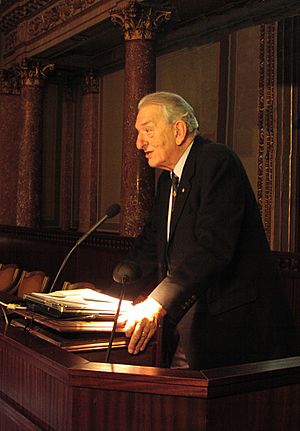George Andrew Olah facts for kids
Quick facts for kids
George Andrew Olah
|
|
|---|---|
 |
|
| Born | May 22, 1927 |
| Died | March 8, 2017 (aged 89) |
| Nationality | Hungarian |
| Alma mater | Budapest University of Technology and Economics |
| Known for | carbocations using superacids |
| Awards | Nobel Prize in Chemistry 1994 |
| Scientific career | |
| Fields | chemistry |
| Institutions | Case Western Reserve University University of Southern California |
George Andrew Olah (born May 22, 1927 – died March 8, 2017) was a famous chemist. He was born in Hungary but later became an American citizen. He won the Nobel Prize in Chemistry in 1994 for his amazing work.
Dr. Olah studied tiny charged particles called carbocations. He used very strong acids, known as superacids, to understand how these particles behave. His discoveries helped us learn more about how chemical reactions happen.
Contents
About George Olah
George Olah was born in Budapest, Hungary, on May 22, 1927. He went to high school there and later studied and taught at the Budapest University of Technology and Economics.
Moving to a New Country
After a big event in Hungary in 1956, George and his family moved away. They first went to England for a short time. Then, they moved to Canada. In Canada, he worked at a company called Dow Chemical. This is where he started his important research on carbocations.
In 1965, he left Dow Chemical to work at Case Western Reserve University. Later, in 1977, he joined the University of Southern California. In 1971, he became a citizen of the United States.
Later Life and Awards
George Olah was a respected professor at the University of Southern California. He also led a research center called the Loker Hydrocarbon Research Institute.
He believed that methanol could be a very important fuel for the future. This idea is called the "methanol economy."
The Olah family created a special fund to help other chemists. This fund gives awards each year to scientists who do excellent work in chemistry.
George Olah passed away on March 8, 2017, at his home in Beverly Hills, California, when he was 89 years old.
His Scientific Work
George Olah's most famous work was about carbocations. These are molecules that have a positive electric charge. He found ways to make these carbocations stable, which means they wouldn't break apart quickly.
Discovering Protonated Methane
One of his big discoveries was finding "protonated methane." Imagine a methane molecule (CH4), which is a gas we use for fuel. Protonated methane is a methane molecule that has an extra proton (a tiny positively charged particle). This gives it a positive charge.
He used superacids, like "Magic Acid," to make and study protonated methane. Here's how it generally works:
- CH4 + H+ → CH5+
Studying Fuels
Dr. Olah also studied how different types of hydrocarbons (which are found in fuels like gasoline) could be used. He looked at how they react and change.
In his later years, his research focused more on the methanol economy. This is the idea of using methanol as a main fuel source instead of traditional fuels like oil and gas. He thought methanol could be a cleaner and more sustainable energy option for cars and other uses.
See also
 In Spanish: George A. Olah para niños
In Spanish: George A. Olah para niños

